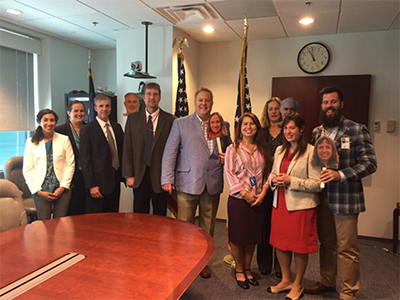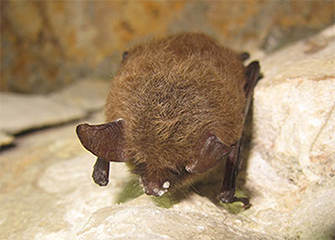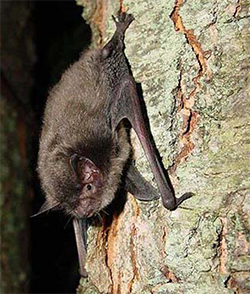
Indiana Bat and Northern Long-Eared Bat Programmatic Consultation Streamlines Project Delivery and Improves Conservation Outcomes
For 43 years, the Endangered Species Act (ESA) has protected the most vulnerable wildlife and plants across the United States. The ESA protects and promotes healthy ecosystems that provide clean air and water, and promotes working food chains necessary for environmental and public health. Bats are particularly critical for ecosystems. As pollinators and insect consumers, they generate $3 billion annually in economic value for U.S. agriculture and forestry.

The Indiana Bat and NLEB Working Group signed the Programmatic Biological Opinion in June 2016 (courtesy of Sharyn LaCombe, FTA)
To protect these important animals, the Federal Highway Administration (FHWA), Federal Railroad Administration (FRA), and Federal Transit Administration (FTA), partnered with the U.S. Fish and Wildlife Service (USFWS) to develop a range-wide programmatic consultation for transportation impacts to two federally-listed bat species: the endangered Indiana bat (Myotis sodalis) and the threatened Northern Long-Eared bat (NLEB) (Myotis septentrionalis).
The resulting range-wide programmatic consultation and conservation strategy for the Indiana Bat and Northern Long-Eared Bat demonstrates how interagency cooperation and coordination can facilitate meaningful species conservation while reducing the time, cost, and workload associated with the compliance requirements in Section 7(a) of the ESA. These requirements ensure that Federal agencies do not jeopardize any listed species.
Bat Populations Face Severe Declines Due to Natural and Human Stressors
The Indiana bat has been a federally-listed endangered species since 1966. The species’ range covers most of the eastern half of the United States, crossing 22 States, with the majority of its hibernacula—shelter where animals hibernate—located in southern Indiana. Since the species’ inclusion on the endangered species list, the 2005 population of roughly 457,000 Indiana bats has declined by nearly 50 percent. Scientists attribute this steep decline primarily to human disturbance, including cave commercialization and improper gating. The latter occurs when caves are fitted with gates to keep people out, but those gates may impede the movement of bats, or alter the airflow, temperature, or humidity inside the cave. Summer habitat loss or degradation, pesticide application, and environmental contamination have also contributed to the decline in the Indiana bat population.
Programmatic Consultation Working Group
Federal Highway Administration
Federal Railroad Administration
Federal Transit Administration
U.S. Fish and Wildlife Service
U.S. Department of Transportation John. A Volpe National Transportation Systems Center
Over the past ten years, the emergence of white-nose syndrome (WNS) has compounded the Indiana bat’s population decline. WNS, named after the white fungus that appears on the muzzle and wings of affected bats, has spread rapidly across eastern North America since it was first observed in New York in 2006. WNS has killed more than 6 million bats of multiple species in eastern North America alone. The majority of Indiana bats hibernate in only a few caves, the largest of which house 20,000 to 50,000 bats. Thus, a single outbreak of WNS can affect a large portion of the total population.
The NLEB’s range is even greater, covering 37 States: Maine to North Carolina on the Atlantic Coast, westward to eastern Oklahoma and north through the Dakotas, and reaching into eastern Montana and Wyoming. The NLEB has been particularly devastated by WNS; between 2006 and 2015, the population of NLEBs declined by 99 percent in the Northeast, its primary habitat. Due to severe declines and continued spread of the disease, the ESA listed the NLEB as threatened in April 2015. The USFWS also released a 4(d) Programmatic Biological Opinion in January 2016, which specifically outlines take (to harass, harm, pursue, hunt, shoot, wound, kill, trap, capture, or collect any threatened or endangered species) prohibitions related to the NLEB in their hibernacula and within areas affected by WNS.
Multi-Agency Group Creates Programmatic Framework to Standardize Bat Consultations
Historically, federally-funded transportation projects have used a variety of consultation and mitigation approaches to protect Indiana bats and NLEBs. In 2012, FHWA and USFWS entered into an interagency agreement to develop a programmatic consultation process and conservation strategy. The working group is comprised of members from the FHWA, FRA, FTA, and USFWS, with support from the U.S. Department of Transportation John A. Volpe National Transportation Systems Center.
USFWS and the transportation agencies released a formal programmatic consultation on April 20, 2016, and USFWS signed a Programmatic Biological Opinion into effect on May 20, 2016. The Indiana bat and NLEB programmatic consultation is one of the largest of its kind, spanning five regions and 38 States. By standardizing interagency policies, the programmatic consultation and Biological Opinion are expected to increase the consistency of project design and review, condense consultation process timeframes, reduce delays, and contribute meaningfully to the conservation of both species.
Range-wide Effects Analysis Promotes Consistency among Transportation Agencies
Under the programmatic consultation, transportation agencies must determine the effect of project actions on the Indiana bat and NLEB. Actions may be classified as No Effect (NE), Not Likely to Adversely Affect (NLAA), or Likely to Adversely Affect (LAA). These classifications allow projects that do not impact the species to proceed without further delays, while providing clear guidelines for projects categorized as NLAA and LAA. Rather than prohibiting all adverse impacts in protected areas, the programmatic consultation enables necessary infrastructure projects to proceed with appropriate conservation and mitigation measures, while safeguarding bat species under the ESA.

An NLEB with visible symptoms of WNS. (courtesy of USFWS)
Projects classified as NE may include those outside of both species’ range, projects inside the species’ range, but with no suitable forested bat habitat, or activities that do not involve construction or percussive elements that will cause noise above existing traffic levels. If the transportation agency documents NE on the Project Submittal Form, no further coordination with USFWS is necessary.
Transportation projects with insignificant effects on either bat species are considered NLAA, and may include projects in areas with confirmed absence of either the NLEB or Indiana bat, or activities that involve maintenance of existing facilities (e.g., rest areas, stormwater detention basins, road striping) that do not directly remove or alter bat habitat.
Projects which are NLAA or LAA for either the Indiana bat or NLEB must demonstrate implementation of appropriate conservation and/or mitigation measures.
New Conservation Strategy Allows for Mitigation in Advance of Impacts
All projects that may affect the Indiana bat or the NLEB must implement action-specific avoidance and mitigation measures (AMMs) to ensure that impacts have been mitigated to the point of insignificant or discountable effect and allow the project to reach NLAA status. For example, in transportation projects where lighting may prove disruptive to either the Indiana bat or the NLEB, the programmatic consultation establishes two AMMs: First, temporary lighting should be directed away from suitable habitat during the active season; and second, the project should use downward-facing lens lights and should direct lighting away from suitable habitat. In cases where adverse effects to either bat species cannot be avoided, projects may apply conservation measures to offset impacts using one of the following options:
- National in-lieu fee program (in progress, to be administered by The Conservation Fund)
- Approved conservation banks
- Local in-lieu fee programs approved by USFWS
- A State/local conservation project
For more information on effects, determinations, and AMMs, please see the User’s Guide for the Range-wide Programmatic Consultation for the Indiana Bat and the NLEB.
Programmatic Consultation Streamlines Project Delivery While Protecting Listed Bats

An Indiana bat perches on a roost tree. (courtesy of USFWS)
To date, the programmatic consultation has been used on over 919 projects across 18 States. Prior to the programmatic, all consultations were conducted on a project-by-project basis. The programmatic consultation streamlines the process for transportation projects and negates the need for project-level effect analyses and individual consultations with the USFWS, reducing the timeline on project approval from months, or even years, to 30 days or less.
Two tiers of review apply to transportation projects depending on the severity of impacts to the species:
- Tier 1: The one-tiered process applies to NLAA projects and allows USFWS 14 days of review after the project is submitted with no formal concurrence needed.
- Tier 2: For LAA projects, a two-tiered process allows USFWS 30 days for review after receipt of a completed application package. USFWS completes an incidental take statement for the Indiana bat and the NLEB, the latter under the 4(d) Programmatic Biological Opinion.
All communications now occur within this well-defined programmatic framework, so there is considerably less back-and-forth between USFWS and the applying transportation agency. By using the programmatic consultation, Federal, State, and local agencies can consistently assess the impact of highway construction and expansion projects on the Indiana bat and NLEB and minimize and mitigate those impacts. The process increases the transparency of the consultation process for transportation agencies, while simultaneously reducing the workload of agency staff.
Successes in Stewardship is a Federal Highway Administration newsletter highlighting current environmental streamlining and stewardship practices from around the country. Click here to subscribe, or call (617) 494-3719 for more information.

